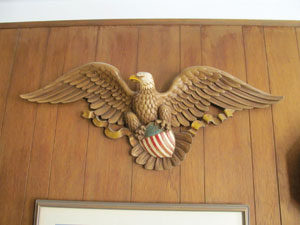
I possess my own theories about Early American Colonial Design style in the USA in the mid 20th century. I should know. I lived through this most unfortunate era in design myself.
Early American served as my introduction to Art. I grew up in a rural area of Illinois, and the little red brick two-bedroom house I occupied with three other kids and parents was a lesson in Mid-American Neo-Colonial “Early American” design.
My mother, herself a first generation American, decorated the mock-fireplace hearth with a life sized reproduction of Emanuel Leutze‘s symbolic (painted in Germany in 1851, not in America in 1776) painting called “Washington Crossing the Delaware.” On the right of the mock-hearth sat a full-size reproduction in Maple of an early American spinning wheel. On the other side sat a milk glass reproduction of an early American whale oil lamp on a two tiered maple chunky round table. The hobnail glass shades of course veiled light bulbs behind the white milk glass. My parents painted the walls Williamsburg Green.
So I know a lot about the era of design of the object in the photograph Philip, whose parents live here in Santa Barbara, sent me. The photo shows an American bald eagle plaque, a spread eagle, which grasps the red, white and blue shield in one talon and the bundle of arrows in the other, symbolizing the power of war, or, as I will explain, the power of a symbol reverting to sentimentality.
Most of these mid-20th-century decorative wall relief plaques came composed of wire supported plaster and then gilded and/or painted. But that’s the cheap composition of the mid-20th century eagles. The early 19th century eagles which date from the REAL Federal Period are usually hand-carved out of hard wood and gold leafed, and are not decorative wall plaques but functional wall brackets. These early 19th century eagles are much less chunky looking, more realistically carved and fiercer looking, reflecting not sentimentality but a hard-won new pride. A good early real Colonial, or to use the proper term, Federal, eagle will run you a starting price of $1,000 and up, and are usually not all that large.
Let’s look at the origins of the style in the Federal period, when Congress in 1782 adopted the Great Seal as envisioned by artist Charles Thomson in 1780. Thomson drew on a long history of representing Democratic power with the imagery of Imperial Rome. Congress discussed many Imperial symbols, held three meetings of three committees over time to refine the symbolism of our Great Seal. At first the design featured a two-headed eagle (think Julius Caesar), a Goddess of Victory (think Athena) with an eagle, and finally an eagle with shield, above olive branches and 13 arrows, with the banner “E Pluribus Unum.” It took a lot of arguing to get to the finished eagle in Congress.
Benjamin Franklin hated the eagle symbol. He said the eagle should not serve as an example to a young America as the eagle “lives by sharping and robbing; he is generally poor and often very lousy.” (Letter 1/26/1784 to Franklin’s daughter Mrs. Sarah Bache, Philadelphia).
As we’ve seen, the eagle isn’t just an American symbol, although the bald eagle is native only to North America. Many historical cultures consider the eagle the top bird. Zeus had one for a companion, so did Jupiter, so did Odin, and so did, supposedly, St. John. The eagle graces not only our Great Seal but the flags of the French Empire, Poland, Romania, Indonesia, Austria and Mexico. He’s the top bird in Medieval European heraldic coats of arms. So our bird isn’t so special. In fact, Ben Franklin nominated the American turkey instead. Thus the establishment of the symbol of the American Bald Eagle in the (Colonial) Federal period. Artwork representing the American eagle in this period is top-notch, and very valuable.
The next era in which we see interior decoration in the Early American or Colonial style, featuring, of course, eagles, is in the mid 19th century. One can understand why. We suffered through the Civil War, and the Union Regiments took up the symbol of the eagle, such as the Wisconsin Company C, 8th Regiment Volunteers (The Eagle Regiment). In the case of Company C, the eagle served as more than a symbol but a live bird. Yes, an eagle really fought with the regiment, a live eagle mascot named “Old Abe,” called, by the opposing Confederate troops as he swooped overhead, “The Yankee Buzzard.” Old Abe lasted out the Civil War only to be killed in a display cage in the Wisconsin State Capital from smoke inhalation. Old Abe was stuffed, burnt again in a fire, replaced with another stuffed eagle, and is still on display there.
The next period of Early American (Colonial) décor occurred during my youth (mid 20th century) when everyone owned Ethan Allen furniture, Duncan Phyfe tables and chairs, spinning wheels, George Washington rag rugs, pineapple door knockers and eagle relief plaques like Philip’s parents. This last era of Neo-Colonialism sticks in my mind as the worst.
All early American furniture was maple, eagles were everywhere, and all upholstered furniture sported ruffled bottoms. My mother even managed to get stiff Herculon to ruffle around the base of the early American platform rocker and early American love seat in our Williamsburg Green living room. Rustic early American faux wood wall paneling, as pictured behind Philip’s eagle plaque, might’ve covered our walls if Dad had been handier. Luckily, Sears offered an Early American paint colors section which contributed to our décor back in Illinois and saved us from faux wood paneling.
Philip’s mid-20th cnetury plaster eagle is worth $35.
Pingback: Duncan Phyfe's Neoclassical Style - Elizabeth Appraisals